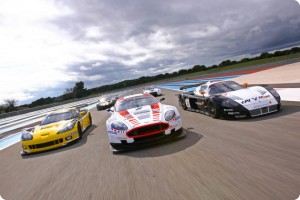- 0
*
MARK THURSFIELD is a journalist and PR advisor, working across sports from skiing to motorsport. After founding his own sports magazine in the 90s, he worked for Eurosport TV then Sportal.com – the first major sports site of the dot com boom – before setting up on his own in 2001. He also plays a mean bass guitar …
.
.
.
.
By Mark Thursfield
11 March 2010
While the UK sports pages have been filled with the phony war between Jenson Button and Lewis Hamilton, last week’s biggest new development in motorsport went widely unreported.
Under the watchful eye of the FIA President, Jean Todt, the brand-new FIA GT1 World Championship was launched in central Paris. The new series became the FIA’s fourth world championship, sitting alongside Formula One, World Rally and World Touring Cars.
And there is every reason to believe that it will be its most exciting too.
Uniquely it is the FIA’s first world championship solely for private teams, rather than for manufacturers. That strategy is aimed at avoiding the seemingly endless cycle of boom and bust in motor sport, where manufactures get involved directly, budgets go sky high – and then they leave. This is a series that aims to stay around.
The line-up of competing marques is impressive, with Aston Martin, Corvette, Ford, Lamborghini, Maserati and Nissan each supplying two two-car private teams, making up a 12-team, 24-car grid.
If you think that Lamborghini and Nissan are perhaps rather strange bed-fellows, don’t.
The GT-R has become an iconic car and has its own fan clubs all around the world. And in the world of gaming, Need for Speed it is the ultimate must-have. In fact, Need for Speed is the biggest selling racing game in history, easily outselling any F1 games and shifting over 100 million units.
The sight and sound of a 24-car GT1 is is one that takes your breath away, almost literally. I was lucky enough to watch the start of a GT1 race from on top of the podium at Silverstone last year, and as the cars came past for their rolling start, I felt like I’d been punched in the gut.
 Without getting too Clarkson on you, the thought that came into my mind was ‘This is what the end of the world sounds like’; it was a mixture of beauty and terror. And visually, as the cars swept over the brow of the hill, it seemed utterly impossible that they would all emerge the other side in one piece. There didn’t seem to be enough room.
Without getting too Clarkson on you, the thought that came into my mind was ‘This is what the end of the world sounds like’; it was a mixture of beauty and terror. And visually, as the cars swept over the brow of the hill, it seemed utterly impossible that they would all emerge the other side in one piece. There didn’t seem to be enough room.
There was, of course, and they did.
The series, which gets underway at the stunning Yas Marina circuit in Abu Dhabi in April, will visit 10 countries on four continents. Stopping off at some of the world’s classic circuits including Silverstone, Spa-Francorchamps, Nurburgring, Paul Ricard, and Interlagos, the first season will reach its climax at the spectacular San Luis circuit in Argentina, which is built around the crater of a volcanic lake and is one of the world’s most spectacular racetracks.
GT racing has in the past always been associated with endurance racing, and wasn’t always the easiest thing to follow. The new championship has addressed that, featuring 20 one-hour races, a move designed to make it a clear, attractive and understandable proposition for broadcasters and the media alike.
To make the racing even more exciting the cars all undergo an FIA ‘balance of performance’ test, designed to equalise the performance and lap-times of the cars, creating close racing. Overtaking is, after all, the thing that race fans like to see the most of.
The aim is to keep the series as open as possible, letting race fans get close to these exotic and awe-inspiring machines; truly they’re things of beauty. And they have racing in their DNA.
With stunning cars and classic marques and a line-up of ex-F1 pilots among many of the world’s top sports car drivers, this is a championship that really does have the potential to create an alternative voice in the world of motorsport.
.










